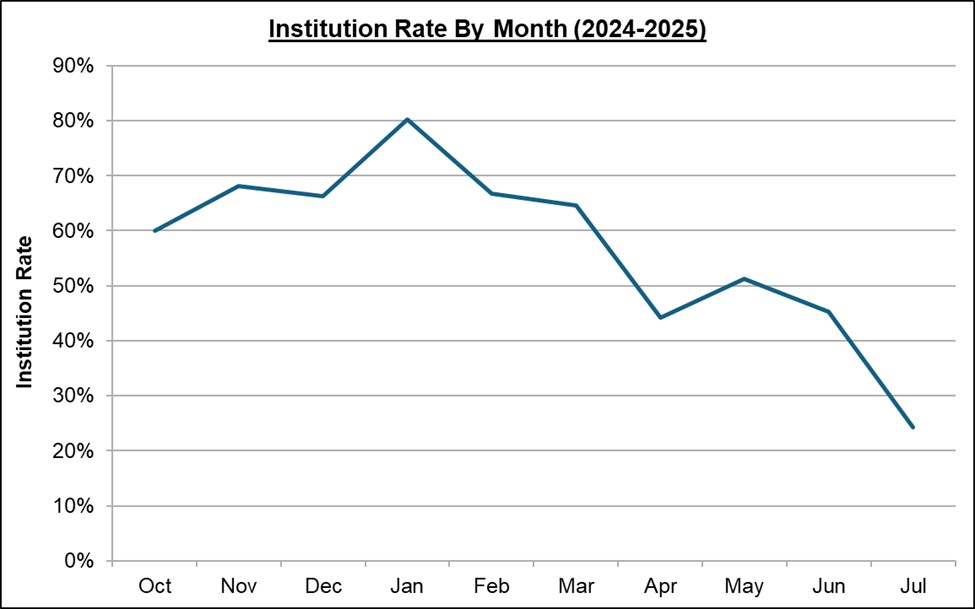By Adam Cook, Daniel Sloan, and Matt Johnson –
Since the inception of the bifurcated review process at the PTAB, Jones Day has been analyzing every discretionary decision released by the Office. Deputy Director Coke Morgan Stewart continues to be the key decisionmaker here because, shortly after his confirmation, USPTO Director John Squires delegated the authority to exercise discretion on institution of AIA proceedings to the Deputy Director. The following statistics show the landscape of the bifurcated review process as of October 9, 2025.
The Deputy Director (and an APJ who has filled in when she was recused) have decided 526 cases. The discretionary denial rate is 61%.
The institution rate has dropped significantly over the past year due in part to an increase in discretionary denials since the start of the bifurcated review process in May.
Factors cited for the denials vary, but some factors are explicitly considered by the Deputy Director more often than others.
Fifty-nine percent (188/319) of denials were based on Fintiv. The settled expectations of the patent owner favored denial in 60% (190/319) of denials, two cases more than Fintiv. Meanwhile, § 325(d) (whether the same or similar prior art or arguments were previously presented) weighed against the petitioner in nine denials (3%). In five denials (2%), the Deputy Director explicitly found that there was no material error during prosecution. An additional factor that commonly favors denial, when applicable, is whether the patent was (or is being) challenged in prior (or ongoing) proceedings, such as district court litigations, IPRs, or ex parte reexaminations.
As shown above, settled expectations is the most common factor that favors denial in a discretionary denial. Settled expectations depends heavily on the age of the challenged patent. The following graph depicts discretionary denial success as related to the age of the challenged patent. While each petition challenges one patent, the same patent is sometimes challenged by serial petitions. Each challenge counts as one data point, so if a patent was challenged twice, both challenges are represented in the graph. Thus, successful and unsuccessful challenges to the same patent are counted. Each patent’s age is also rounded down to the nearest full year (e.g., a 5-years-and-11-months-old patent is considered 5 years old).
Data Collection Methodology:
Data was obtained by searching Docket Navigator and the USPTO’s public docket. Cases were classified by discretionary factors explicitly considered and the party those factors favored. A factor is “explicitly considered” when it is either (i) mentioned by name in the decision (e.g., the decision mentions “the settled expectations of the parties”) or (ii) it is alluded to as a considered factor (e.g., the decision considers the age of the patent without mentioning “the settled expectations of the parties” by name). To determine which factors the decisionmaker is addressing when it is unclear on the face of the decision, the parties’ briefs were analyzed. For this post, a factor favors a particular party when the decision states (i) the factor weighs in favor of or against discretionary denial or (ii) the factor does not tip the balance for or against discretionary denial. For the latter category, the factor was classified as favoring the party opposed to the failed argument.
Matthew Johnson
Latest posts by Matthew Johnson (see all)
- Collateral Estoppel May Not Apply When Claim Interpretation Standards Differ - November 19, 2025
- Proposed Rulemaking Aims to Change Access to IPR Proceedings - November 17, 2025
- Discretionary Decision Statistics Update - November 4, 2025




